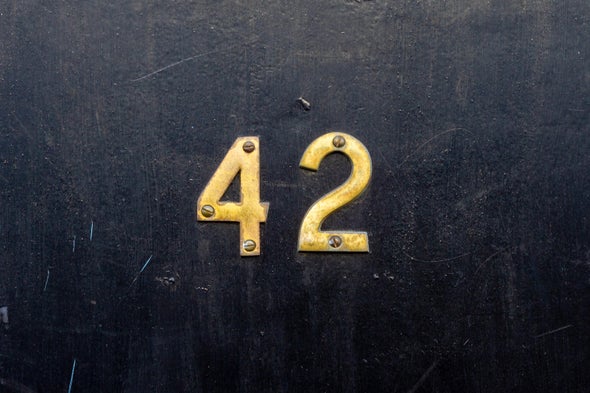
Scientific American
′′ دليل هيتشيكر للمجرة ′′ بواسطة دوغلاس ادمز نشر منذ 42 سنوات هذا الاسبوع. في رواية 42 هو ′′ الاجابة على السؤال النهائي للحياة والكون وكل شيء."
ما هو المميز في الرقم 42؟

كشف سر رقم رياضي حيّر العلماء 65 عاما
عُرف الرقم 42 (على نطاق واسع) بأنه مثابة الإجابة عن سؤال الحياة والكون وكل شيء في دليل "هيتشكر للمجرة": سلسلة الخيال العلمي الكوميدي التي أنشأها دوغلاس آدمز.
ولكن، في حين أن المعد الراحل دوغلاس آدمز، أصر دائما على أنه اختار الرقم عشوائيا لسلسلة رواياته عن الخيال العلمي، إلا أن 42 كان في الواقع محيرا لعلماء الرياضيات منذ عقود.
وحتى الآن، ظلت الحلقة الأخيرة بعيدة المنال في مسألة الرياضيات المعروفة باسم "المعادلة الديفونتية"، وهي معادلة حدودية في متغيرات متعددة تكون حلولها أعدادا صحيحة، أو يبرهن على استحالة ذلك.
ويأتي السؤال الذي يحير علماء الرياضيات، على الشكل التالي: هل يمكن جعل جميع الأرقام تصل إلى 100 من مجموع 3 مكعبات؟. ويُعبّر عن ذلك في التدوين الرياضي، مثل k = x(cubed) + y(cubed) + z(cubed).
وطُرحت المسألة الأصلية، التي سميت تيمنا بـ"الديفونتية" (الأب اليوناني للجبر)، في عام 1954 بجامعة كامبريدج.
ويمكن القول إن بعض الأرقام سهلة- على سبيل المثال، يمكن كتابة الرقم 29 بهذه الطريقة: 3³ + 1³ + 1³ / (27 + 1 + 1)، وثبت أن أرقاما أخرى مثل: 4 و5 و13 و14 لا يوجد لها حل.
ولكن الرقم 42 ظل لغزا محيرا، مع عدم وجود حل وبدون اكتشاف دليل على ذلك.
والآن، قام فريق البحث بقيادة جامعة "بريستول" ومعهد ماساتشوستس للتكنولوجيا (MIT)، بكشف غموض هذا اللغز الرياضي المحير.
واستخدم البروفسور أندرو بوكر، بالتعاون مع أستاذ الرياضيات في معهد ماساتشوستس، أندرو سوذرلاند، محرك Charity (الذي يستخدم الطاقة من أكثر من 500 ألف كمبيوتر منزلي).
وتوصلوا إلى الإجابة، التي استغرقت أكثر من مليون ساعة من الحساب لإثباتها، وهي: X = -80538738812075974 وY = 80435758145817515 وZ = 12602123297335631.
وقال الأستاذ بوكر: "أشعر بالارتياح، في هذه اللعبة، من المستحيل أن تتأكد من أنك ستجد شيئا ما. إن الأمر يشبه إلى حد ما محاولة التنبؤ بالزلزال. لذا، قد نجد ما نبحث عنه في بضعة أشهر من البحث، أو قد لا يكون الحل متاحا لقرن آخر من الزمن".
المصدر: ديلي ميل
ما هو المميز في الرقم 42؟

كشف سر رقم رياضي حيّر العلماء 65 عاما
عُرف الرقم 42 (على نطاق واسع) بأنه مثابة الإجابة عن سؤال الحياة والكون وكل شيء في دليل "هيتشكر للمجرة": سلسلة الخيال العلمي الكوميدي التي أنشأها دوغلاس آدمز.
ولكن، في حين أن المعد الراحل دوغلاس آدمز، أصر دائما على أنه اختار الرقم عشوائيا لسلسلة رواياته عن الخيال العلمي، إلا أن 42 كان في الواقع محيرا لعلماء الرياضيات منذ عقود.
وحتى الآن، ظلت الحلقة الأخيرة بعيدة المنال في مسألة الرياضيات المعروفة باسم "المعادلة الديفونتية"، وهي معادلة حدودية في متغيرات متعددة تكون حلولها أعدادا صحيحة، أو يبرهن على استحالة ذلك.
ويأتي السؤال الذي يحير علماء الرياضيات، على الشكل التالي: هل يمكن جعل جميع الأرقام تصل إلى 100 من مجموع 3 مكعبات؟. ويُعبّر عن ذلك في التدوين الرياضي، مثل k = x(cubed) + y(cubed) + z(cubed).
وطُرحت المسألة الأصلية، التي سميت تيمنا بـ"الديفونتية" (الأب اليوناني للجبر)، في عام 1954 بجامعة كامبريدج.
ويمكن القول إن بعض الأرقام سهلة- على سبيل المثال، يمكن كتابة الرقم 29 بهذه الطريقة: 3³ + 1³ + 1³ / (27 + 1 + 1)، وثبت أن أرقاما أخرى مثل: 4 و5 و13 و14 لا يوجد لها حل.
ولكن الرقم 42 ظل لغزا محيرا، مع عدم وجود حل وبدون اكتشاف دليل على ذلك.
والآن، قام فريق البحث بقيادة جامعة "بريستول" ومعهد ماساتشوستس للتكنولوجيا (MIT)، بكشف غموض هذا اللغز الرياضي المحير.
واستخدم البروفسور أندرو بوكر، بالتعاون مع أستاذ الرياضيات في معهد ماساتشوستس، أندرو سوذرلاند، محرك Charity (الذي يستخدم الطاقة من أكثر من 500 ألف كمبيوتر منزلي).
وتوصلوا إلى الإجابة، التي استغرقت أكثر من مليون ساعة من الحساب لإثباتها، وهي: X = -80538738812075974 وY = 80435758145817515 وZ = 12602123297335631.
وقال الأستاذ بوكر: "أشعر بالارتياح، في هذه اللعبة، من المستحيل أن تتأكد من أنك ستجد شيئا ما. إن الأمر يشبه إلى حد ما محاولة التنبؤ بالزلزال. لذا، قد نجد ما نبحث عنه في بضعة أشهر من البحث، أو قد لا يكون الحل متاحا لقرن آخر من الزمن".
المصدر: ديلي ميل


تعليق